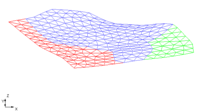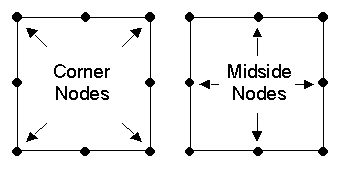GMS:2D Mesh Tool Palette: Difference between revisions
From XMS Wiki
Jump to navigationJump to search
No edit summary |
No edit summary |
||
| (7 intermediate revisions by the same user not shown) | |||
| Line 1: | Line 1: | ||
{{2D Mesh links}} | {{2D Mesh links}} | ||
The following tools are contained in the dynamic portion of the [[GMS:Toolbars| | The following tools are contained in the dynamic portion of the [[GMS:Toolbars|tool palette]] when the [[GMS:2D Mesh Module|2D Mesh Module]] is active. Only one tool is active at any given time. The action that takes place when clicking in the [[GMS:The GMS Window|Graphics Window]] depends on the current tool. The following table describes the tools in the 2D Mesh tool palette. | ||
{| class="wikitable" | {| class="wikitable" | ||
! Tool !! width ="125" | Tool Name !! Description | ! Tool !! width ="125" | Tool Name !! Description | ||
|- | |- | ||
| align = "center" | [[File:Select Point | | align = "center" | [[File:Select Point Tool.svg|16 px]] || '''Select Nodes''' {{Anchor|Select Nodes}}|| The '''Select Nodes''' tool is used to select a set of nodes for some subsequent operation such as deletion. The coordinates of a selected node can be edited by dragging the node while this tool is active. The coordinates of selected nodes can also be edited using the [[GMS:The GMS Window|''Edit Window'']]. A node can also be selected by using the '''Find Node''' command in the ''Mesh'' menu. A prompt will ask for a node ID and the node is selected. Any previously selected nodes are unselected. | ||
|- | |- | ||
| align = "center" | [[ | | align = "center" | [[File:GMS Select Triangle Tool.svg|16 px]] || '''Select Elements''' {{Anchor|Select Elements}} || The '''Select Elements''' tool is used to select a set of elements for operations such as deletion or assigning a material type. An element can also be selected by using the '''Find Element''' command in the ''Mesh'' menu. A prompt will ask for an element ID and the element is selected. Any previously selected elements are unselected. | ||
|- | |- | ||
| align = "center" | [[ | | align = "center" | [[File:Select Vertex String Tool.svg|16 px]] || '''Select Node Strings''' {{Anchor|Select Node String}}|| The '''Select Node Strings''' tool is used to select one or more strings of nodes. Node strings are used for operations such as adding breaklines to the mesh. | ||
The procedure for selecting node strings is somewhat different than the normal selection procedure. Strings are selected as follows: | The procedure for selecting node strings is somewhat different than the normal selection procedure. Strings are selected as follows: | ||
| Line 19: | Line 19: | ||
To remove the last node from a string, press the Backspace key. To abort entering a node string, press the ''ESC'' key. To end a node string, press Return or double-click on the last node in the string. Another node string can then be selected. | To remove the last node from a string, press the Backspace key. To abort entering a node string, press the ''ESC'' key. To end a node string, press Return or double-click on the last node in the string. Another node string can then be selected. | ||
|- | |- | ||
| align = "center" | [[File:Create | | align = "center" | [[File:Create Points Tool.svg|14 px]] || '''Create Nodes'''{{Anchor|Create Nodes}}|| The '''Create Nodes''' tool is used to manually add nodes to a mesh. When this tool is selected, clicking on a point within the Graphics Window will place a node at that point. What happens to the node after it is added (whether and how it is triangulated into the mesh) depends on the settings in the ''Node Options'' dialog in the ''Modify Mesh'' menu. | ||
|- | |- | ||
| align = "center" | [[ | | align = "center" | [[File:GMS Create Linear Triangle Element Tool.svg|16 px]] || '''Create Linear Triangle Element''' || rowspan = "4" | Four types of elements are supported by the 2D Mesh module: | ||
#[[ | #[[File:GMS Create Linear Triangle Element Tool.svg|16 px]] Three node triangles (linear triangles). | ||
#[[ | #[[File:GMS Create Triangle Element Tool.svg|16 px]] Six node triangles (quadratic triangles). | ||
#[[ | #[[File:GMS Create Linear Quad Element Tool.svg|16 px]] Four node quadrilaterals (linear quadrilaterals). | ||
#[[ | #[[File:GMS Create Quad Element Tool.svg|16 px]] Eight node quadrilaterals (quadratic quadrilaterals). | ||
Elements can be created using automatic meshing techniques such as triangulation. However, it is often necessary to edit a mesh by creating elements one at a time using the four Create Element tools. | Elements can be created using automatic meshing techniques such as triangulation. However, it is often necessary to edit a mesh by creating elements one at a time using the four Create Element tools. | ||
| Line 42: | Line 42: | ||
GMS performs several checks when a new element is constructed. The new element is checked to see whether or not it is ill-formed (the element has a twist in it or is self intersecting). The element is also checked to see if it overlaps any of the elements adjacent to the nodes comprising the new element. In addition, the elements adjacent to a new element are checked to ensure that the elements are conforming, i.e., linear elements (three and four node elements) are not allowed to be placed adjacent to quadratic elements (six and eight node elements). If any of the above checks fail, the construction of the new element is aborted.--> | GMS performs several checks when a new element is constructed. The new element is checked to see whether or not it is ill-formed (the element has a twist in it or is self intersecting). The element is also checked to see if it overlaps any of the elements adjacent to the nodes comprising the new element. In addition, the elements adjacent to a new element are checked to ensure that the elements are conforming, i.e., linear elements (three and four node elements) are not allowed to be placed adjacent to quadratic elements (six and eight node elements). If any of the above checks fail, the construction of the new element is aborted.--> | ||
|- | |- | ||
| align = "center" | [[ | | align = "center" | [[File:GMS Create Triangle Element Tool.svg|16 px]] || '''Create Quadratic Triangle Element''' | ||
|- | |- | ||
| align = "center" | [[ | | align = "center" | [[File:GMS Create Linear Quad Element Tool.svg|16 px]] || '''Create Linear Quadrilateral Element ''' | ||
|- | |- | ||
| align = "center" | [[ | | align = "center" | [[File:GMS Create Quad Element Tool.svg|16 px]] ||''' Create Quadratic Quadrilateral Element ''' | ||
|- | |- | ||
| align = "center" | [[File:GMS Merge Split Tool.svg|16 px]] || '''Merge/Split''' {{Anchor|Merge/Split}} || If the '''Merge/Split''' tool is selected, clicking on a triangle edge with the mouse cursor will cause the two triangular elements adjacent to the edge to be merged into a quadrilateral element provided that the quadrilateral shape formed by the two triangles is not concave. | | align = "center" | [[File:GMS Merge Split Tool.svg|16 px]] || '''Merge/Split''' {{Anchor|Merge/Split}} || If the '''Merge/Split''' tool is selected, clicking on a triangle edge with the mouse cursor will cause the two triangular elements adjacent to the edge to be merged into a quadrilateral element provided that the quadrilateral shape formed by the two triangles is not concave. | ||
| Line 52: | Line 52: | ||
The '''Merge/Split''' tool can also be used to undo a merge or to "unmerge" a quadrilateral element. A quadrilateral element can be split into two triangles by clicking anywhere in the interior of the element. This tool is useful if a pair of triangles are inadvertently merged. | The '''Merge/Split''' tool can also be used to undo a merge or to "unmerge" a quadrilateral element. A quadrilateral element can be split into two triangles by clicking anywhere in the interior of the element. This tool is useful if a pair of triangles are inadvertently merged. | ||
|- | |- | ||
| align = "center" | [[ | | align = "center" | [[File:GMS Swap Edge Tool.svg|16 px]] || '''Swap Edges''' {{Anchor|Swap Edges}} || If the '''Swap Edges''' tool is selected, clicking on the common edge of two adjacent triangles will cause the edge to be swapped as long as the quadrilateral shape formed by the two triangles is not concave. | ||
Occasionally, it is useful to interactively or manually swap the edges of two adjacent triangles. This can be thought of as a quick and simple alternative to adding breaklines to ensure that the edges of the triangular elements honor a geometrical feature that needs to be preserved in the mesh. | Occasionally, it is useful to interactively or manually swap the edges of two adjacent triangles. This can be thought of as a quick and simple alternative to adding breaklines to ensure that the edges of the triangular elements honor a geometrical feature that needs to be preserved in the mesh. | ||

